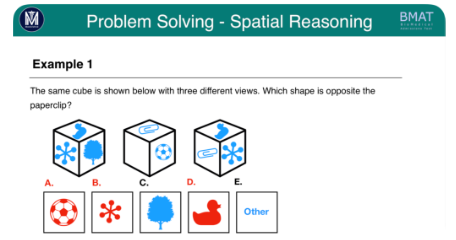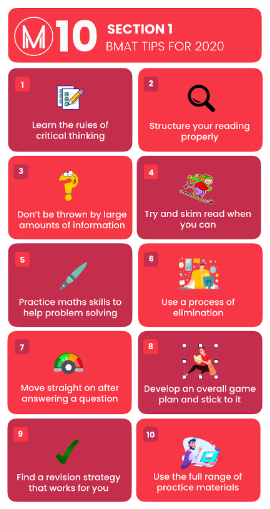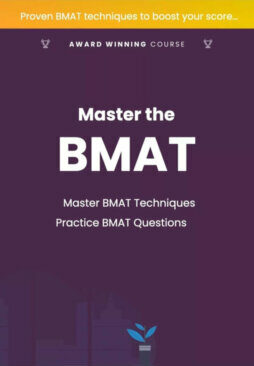UPDATE: Please note that CAAT have announced they will no longer be administering the BMAT in 2024, for 2025 entry. Cambridge University has announced that they will be using the UCAT as an admissions indicator. Oxford University are to announce admissions test changes in Spring 2024.
Ultimate Guide to the BMAT Section 1
BMAT Section 1: What is it?
Section 1 of the BMAT lasts 60 minutes and it broadly tests candidates’ thinking skills, which is described by The Cambridge Admissions Assessment Testing as a test of general skills often required for undergraduate studies. For some candidates, Section 1 might seem like the hardest section and is their biggest obstacle in achieving a high BMAT result because it emphasises more abstract intellectual ability than scientific expertise. However, the silver lining is that Section 1 could instead help certain applicants pull up their BMAT scores, especially those who struggle with time restrictions. This is because there are only 32 questions in the test, and an hour to answer them. Hence, BMAT Section 1 could be advantageous with the proper preparation technique.
What kind of questions are tested?
For candidates who are more familiar with the older BMAT format, BMAT Section 1 has undergone slight changes since then. There are fewer questions than previously (down from 35), and questions relating to Data Analysis and Inference, which frequently included evaluating graphs and statistical data, are now no longer tested for future papers. These points would be handy to remember especially when practising BMAT past papers!
However, although there have been some changes, most of the content and specifications remain the same. For example, no calculators are allowed for this section, all questions are multiple-choice, and the other type of questions still remain.
The 32 questions that would be tested in Section 1 can be categorised into two groups of 16 questions. The first type of question is that of problem solving, and the other type is critical thinking. The questions are not categorised by their type, but rather, they are organised in ascending order of difficulty. Hence, this means that there would be a mixture of questions from the two groups, with questions from the two groups interspersed throughout.
Problem Solving
This type of question examines four different ways in which you process numerical information:
- Selection of relevant information: This tests your ability to sieve through a large amount of data and eliminate information that may be redundant or irrelevant. You would then be required to derive conclusions from the relevant material.
- Determining mathematical operations: Using a small amount of information, you would have to come up with a mathematical process and apply that to produce an answer.
- Finding similarity: You would be expected to analyse complementary data sources that are often presented in different ways, such as tables or various chart styles, identify parallels, and draw conclusions that are consistent amongst all the data sources.
- Spatial reasoning: You will be tested on your ability to identify how patterns or objects look in 3-dimensional space.
Although no prior scientific or general knowledge is required, the BMAT Section 1 problem-solving tasks need the following fundamental mathematical abilities:
- Area, perimeter, and spatial understanding
- Being able to interpret graphs and tables
- Calculating averages and percentages
An example of a BMAT Section 1 Problem solving question that tests on Spatial reasoning is as below:

Critical Analysis
This tests your comprehension of key logical argument characteristics, specifically:
- Finding the Main Conclusion: From a paragraph given, you would have to identify what is its main purpose or point. This tests your ability to sieve through statements or sentences that are not the main point, and/ or your ability to understand statements that hint at the purpose of the paragraph even if it is not explicitly stated.
- Drawing a Conclusion: This tests your ability to internalise the information in a paragraph and interpret the meaning and point behind it. Even though the conclusion might not be explicitly stated in the paragraph, it would be consistent with the information given.
- Identifying an assumption: You would be required to find an assumption that is not mentioned but is assumed to be true, in order for the information presented to make sense.
- Assessing the impact of new information: After reading and understanding the text provided, you would then be provided with an additional piece of information and you would have to determine if it would strengthen or weaken the existing argument.
- Detecting reasoning errors: You would be made to find faults or incorrect underlying assumptions that prohibit the conclusion from making sense.
- Matching arguments: Between two different passages, you would have to find a logical process that is used in both texts. The logic would be parallel, even though it is employed in different situations.
- Applying principles: This involves identifying the fundamental idea or principle in the passage and choosing an answer from the multiple choice that is consistent with it.

How do I prepare for BMAT Section 1?
Undoubtedly, the best method to prepare for BMAT Section 1 is to practise previous years’ examination papers and sample questions, ideally in a timed environment that stimulates examination conditions. Although no former papers completely reflect the new format due to the recent specification change mentioned before, you can simply skip the Data analysis and inference questions. This would still provide you with a bank of useful questions that are relevant and would help you hone your answering skills.
For some great tips and tricks on preparing for and scoring in BMAT Section 1, you can read our list of advice below. One important takeaway is that Section 1 preparation cannot be rushed and would be more useful if more time was allocated to it because it often requires more in-depth textual research than Section 2, which is more science-based. Feel free to ask one of our Medic Mind BMAT teachers for assistance if you are struggling with any part of either Problem solving or critical thinking.
How is BMAT Section 1 marked?
No marks are removed for wrong responses, and each question is worth one mark. The total raw marks are then converted to scores between 1.0 (low) and 9.0 (high).
The median score often falls in the range of 5.0 and would represent around half of the marks. Around 10% of test takers have a score of 6.0 or more, which is good, and very few applicants receive a score of 7.0 or higher. 9.0 is the maximum score that you can receive. However, as the scale is based on the range of marks of all the candidates, you can answer a few questions incorrectly and still score a 9.0!
What are your top tips for BMAT Section 1?
Section 1, which makes up half of the BMAT’s duration, can be somewhat scary, especially as it does not cover the same familiar territory as Section 2 in terms of scientific aptitude. Due to this, we have produced our top ten Section 1 tips.

1. Learn the rules of critical thinking
When preparing for Section 1 of BMAT, you should try and familiarise yourself with the features of logical arguments. This would allow you to recognise and identify them more easily when attempting the questions in Section 1. The features that would be tested have been outlined above, but you should take special care in understanding how to identify conclusions from supporting evidence that is given, how to identify assumptions and logical flaws, and how to identify strengths and weaknesses in an argument.
Although some people think that critical thinking is abstract and generally an acquired skill, it is actually more than just a vague term. It is a legitimate academic field, and there are plenty of introductory books on the topic available in libraries and online. If you struggle with being able to do the questions in Section 1 of BMAT, feel free to approach us for 1-to-1 BMAT tutoring from our skilled BMAT tutors.
2. Structure your reading properly
As Section 1 of BMAT is a timed examination, every minute counts and is precious. Hence, you should approach the examination by having a reliable method for answering questions that include lengthy text passages. For example, after reading the question, you can choose between reading the excerpt directly before or after the answer choices.
Both techniques have their advantages, and they should definitely be tailored to your learning and answering style, but we recommend reading the paragraph first. This is because it allows you to develop a response solely based on the passage, without having your judgement clouded by knowledge of the possible answers. Reading the multiple choices first may also cause you to forget what was in the passage, which is not ideal. Hence, always attempt multiple practice papers first to figure out a reading method that works for you to use on exam day.
3. Do not be thrown by large amounts of information
As mentioned earlier, from 2020, Section 1 will no longer contain questions that explicitly assess data analysis and inference. Although this would reduce the number of questions that test your ability to analyse large amounts of information, there are still questions that test this. For example, questions in Section 1 that have long passages will continue to test your ability to identify important details buried inside a sea of extra information.
Therefore, it is important to keep in mind that most of the information you receive will be meaningless and is just provided as a diversion. Hence, it is key for you to focus on the information that really matters and not be distracted.
4. Try and skim read when you can
Building on the advice from the previous tip, we would strongly encourage you to develop the practice of skim reading. When we are under pressure, we often try to read every word of every sentence. This takes up valuable time that we cannot afford to lose, and is not even constructive as research has shown that it does not improve understanding.
Hence, you should try and maximise the amount of time you have whilst not compromising on your understanding by skim reading. You can do so by acquiring a quick overview of the information on your first read, before paying close attention to any keywords, and lastly, only focus more intently on the section of text or data set that contains the answer.
5. Practice Maths skills to help with problem-solving
Although simple arithmetic skills might sound like something that you are already familiar with, it is still important for you to review your timetables and basic arithmetic skills. For example, you should try practising basic mental mathematics such as the ability to square and cube numbers, as well as the ability to convert between decimals and fractions. This would not only help you save valuable time but would also prevent you from making any simple careless mistakes.
6. Use a process of elimination
Using the simple process of elimination would not only enhance your chances of being correct, it would also help you save valuable time as you would not need to go through the lengthy process of actually deriving the correct answer. It comes in particularly handy when the BMAT questions ask you to pick out combinations of true and false statements from a given selection.
7. Move straight on after answering a question
Rereading questions or checking them in order to ensure that you have answered them correctly before continuing might be tempting. However, this would only cause you to waste valuable time. Answering all the questions with a lower rate of accuracy would generally give you a higher score than answering half the questions with a higher rate of accuracy.
Furthermore, as you are most likely to have answered correctly, the questions that you have already completed should be the last questions that you would want to look at again. This advice is included in our guidance for Section 2 of the BMAT, but it’s especially helpful for the lengthy and challenging questions of Section 1, which are best tried with a fresh set of eyes if you want to re-read them.
You can also check your answers once you have completed the whole section, in order to ensure that you have minimally filled in all possible answers!
8. Develop an overall game plan and stick to it
Make a schedule for how you will split your time in the examination and put it into practice. You can do so by calculating the average amount of time you intend to spend on each question and then establishing strict benchmarks for how many questions you must have answered by specific points in the test. You can also decide on whether or not you would like to factor in time for checking your answers into this schedule.
9. Find a revision strategy that works for you
Do not anticipate your Section 1 revision to be as effective as your Section 2 or A Level revision because, as a future doctor, you probably prefer statistics and charts over long blocks of text. Hence, in order to ensure that you are consistent with your revision, you can consider adding more breaks, developing a longer-term preparation approach, and being realistic about how much time you can devote to Section 1 each day.
10. Use the full range of practice materials
In order to improve, just like other examinations, you must practice, practice, and practice! The best way to do so is to use the official BMAT Section 1 sample papers that can be found on the official Cambridge Admissions Assessment Testing website, as well as the fully prepared mock questions and sample papers from Medic Mind. Last but not least, keep in mind that critical thinking talents are meant to be applicable to daily life: try using your newly acquired analytical skills to the argument made in newspapers and publications, or even in words from your friends and family!



